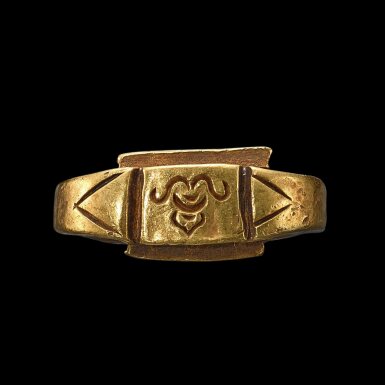Property from an Asian private collection A solid gold ring with an incised bezel of a rampant lionKerala, India, 7th-12th century亞洲私人收藏印度喀拉拉邦 七至十二世紀 獅子紋金戒指
The iconography of the lion is very powerful in Indian culture, regarded as a symbol of courage and wealth. This ring was almost certainly worn as a blessing of fortune. Cultural depictions of the lion in Hindu and Buddhist art of India would be found in the iconography of Lakshmi, the goddess of wealth, power, and prosperity. Religious texts such as the Skunda Purana, Lakshmi Tantra, Markandeva Purana, Devi Mahatmya, and Vedic scriptures commonly describe her to be sitting on a lion as her vahanam, or holy mount. The ring being made of solid gold further associates it with the goddess Lakshmi. For instance, the iconography of the goddess often depicts her wearing gold or having a golden complexion. d. 1.8 cm; 4.71 grams
Property from an Asian private collection A solid gold ring with an incised bezel of a rampant lionKerala, India, 7th-12th century亞洲私人收藏印度喀拉拉邦 七至十二世紀 獅子紋金戒指
The iconography of the lion is very powerful in Indian culture, regarded as a symbol of courage and wealth. This ring was almost certainly worn as a blessing of fortune. Cultural depictions of the lion in Hindu and Buddhist art of India would be found in the iconography of Lakshmi, the goddess of wealth, power, and prosperity. Religious texts such as the Skunda Purana, Lakshmi Tantra, Markandeva Purana, Devi Mahatmya, and Vedic scriptures commonly describe her to be sitting on a lion as her vahanam, or holy mount. The ring being made of solid gold further associates it with the goddess Lakshmi. For instance, the iconography of the goddess often depicts her wearing gold or having a golden complexion. d. 1.8 cm; 4.71 grams















Testen Sie LotSearch und seine Premium-Features 7 Tage - ohne Kosten!
Lassen Sie sich automatisch über neue Objekte in kommenden Auktionen benachrichtigen.
Suchauftrag anlegen